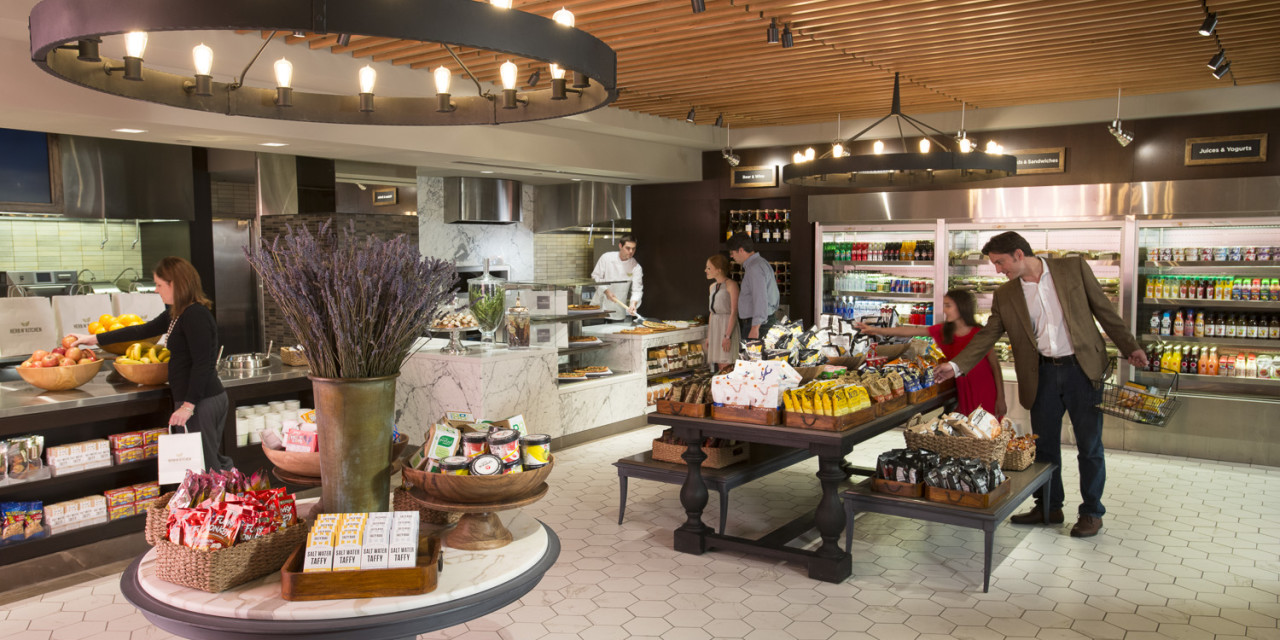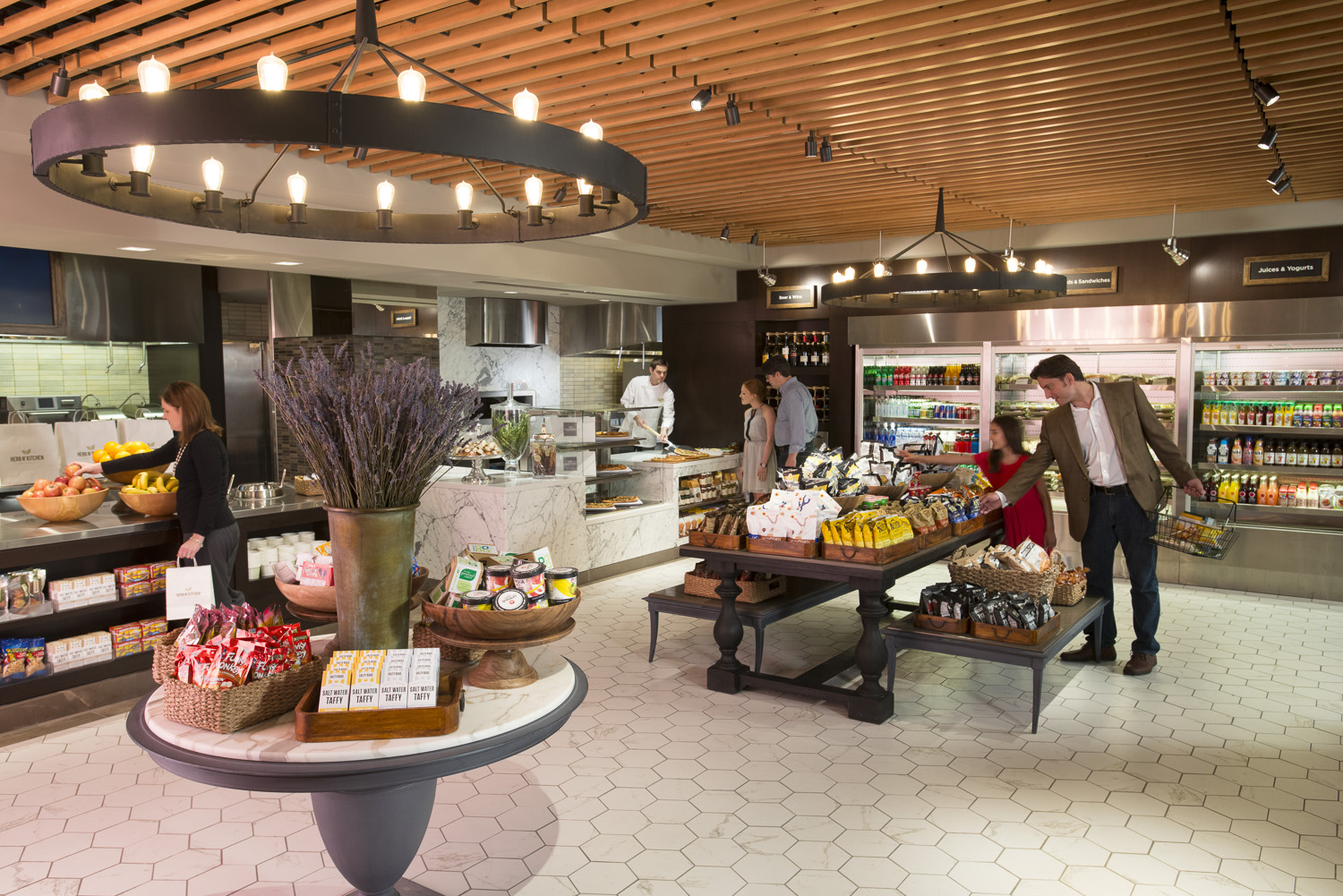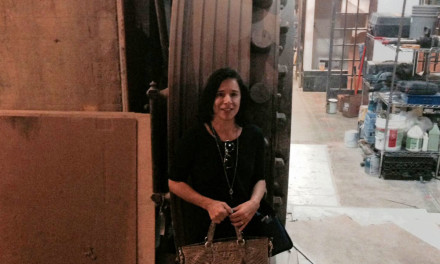NEW YORK – The days of the $30 room-service cheeseburger may be numbered, thanks to new findings from Manhattan’s biggest hotel.
Top executives at the nearly 2,000-room Hilton New York Midtown hotel revealed to Travel Update recently that their controversial decision last year to replace traditional room service with a stripped-down version has been a critical and financial “success.”
“If revenues were down, we would not call it successful,” said Jason Tresh, the hotel’s director of food and beverage.
The newfangled concept hinges on a contemporary restaurant called Herb N’ Kitchen, which has a broad to-go menu that doubles as the room service menu. It better serves the needs of today’s time-pressed guests, especially business travelers, Tresh said.
“We’re seeing a lot of business travelers grab food here before going to meetings. They bypass room service. They don’t want to wait that 45 minutes,” he said. In the past, they would leave the hotel to grab something at a chain such as Au Bon Pain or a deli, he added.
Room service in upscale hotels typically lose money despite costly prices and delivery fees. Simply put, room-service sales generally don’t run high enough to cover expenses related to the dedicated staff and kitchen space required to run the operation. At the Hilton today, there’s just one kitchen instead of two to manage, which controls costs, said Richard Brown, the hotel’s top chef.
The Hilton’s news could influence other hotels to follow suit.
“We have toured everyone in NYC’s food and beverage world,” Laurens Zieren, general manager of the Hilton New York Midtown. Asked about their reaction, he said, “The overall theme is we’re jealous of what you’ve accomplished.”
‘A daring move’
Travel Update recently sat down with Zieren and the hotel’s other top executives for their first in-depth discussion about the controversial move.
TWITTER: Follow Barb for scoops, features
SUBSCRIBE or BOOKMARK: Travel Update blog’s Front Page
The Hilton’s decision, announced about a year ago, to get rid of rolling carts and formal waiter service was criticized by workers as well as some customers who said they still want the traditional silver-domed trays delivered to their room – and are happy to pay for the added pampering.
“It was a daring move in the beginning. You had to take a chance,” said Brown, who came from the five-star St. Regis to take over food operations here two years ago.
The property’s declaration of room service success also flies in the face of critics who said the hotel was crossing a line that shouldn’t be crossed. One question often heard from both consumers and industry insiders alike was this: How would a four-star hotel without traditional room service differentiate itself from a three-star hotel?
Clearly, some people won’t be happy with the new room service model, Zieren said. Among them: Couples who’d like to order a romantic meal up to their room and female business travelers who dislike solo restaurant dining.
“You see guests who love it. You also see a few guests who say that’s not for me,” Zieren said.
Frequent business traveler Rivkah Tuttle is one of those female business traveler who sometimes relies on room service for late dinners. On her current trip, she told Travel Update, she was left frustrated by limited room service hours.
“When I called the front desk after 9 pm, they told me they couldn’t deliver even something like water or fruit at that hour. They simply don’t offer room service now,” Tuttle said via Facebook. “I had to go out to a convenience store, which I wasn’t entirely comfortable with.”
It’s not only women, though.
“I don’t like the idea of room service going away,” said frequent traveler Kerry Boatright. “I prefer full-service hotels for that reason – full service. It’s nice to have the option if you don’t want to get out of a robe to go downstairs.”
Millennials in mind
The controversial move from room “service” to room “delivery,” however, highlights the race by hotel companies to re-evaluate operations through the eyes of Millennial travelers.
Over the last five years, for example, hotels have remade boring lobbies into inviting living rooms – with hip music piped-in – where people can hold impromptu meetings, plug in their laptops, order wine or share food. They’ve also been scrambling to increase the number of power outlets in guest rooms given the higher demand to charge multiple mobile devices.
Room service may be next for disruption
Remember, travelers in the 18-to-33-year-old category grew up with Starbucks. So, not surprisingly, they tend to prefer quick yet customized service similar to what they do when they order a cafe latte in a premium coffee shop.
Healthy food options are popular with this crowd, as is technology. Many hotels, for instance, have witnessed an uptick in guests using apps to order meals from local neighborhood restaurants and bypass room service altogether.
Bottom line: Hotels worry that if they don’t fulfill the needs of today’s and tomorrow’s customers, they might go elsewhere – especially in an age where alternatives such as Airbnb rentals are becoming more popular.
How it works in New York
The newfangled room service style wouldn’t be possible if the hotel hadn’t done away with the old-fashioned, three-meal-a-day hotel restaurant.
- Herb N’ Kitchen’s dining area with communal tables. Photo courtesy of New York Hilton Midtown.
- Photo courtesy of New York Hilton Midtown.
- Salads ready to be delivered to guest rooms at the New York Hilton Midtown. Photo by Barb DeLollis.
- The biggest hotel in New York City (Hilton Midtown) stocks locally made ice cream and gelato. Photo by Barb DeLollis.
The replacement – Herb N’ Kitchen, a restaurant that’s a cross between a Panera Bread location and an upscale New York deli – that’s designed to appeal to more people than the prior restaurant. The hotel wants to attract guests rushing out to business meetings, as well locals who need a morning cappuccino or sandwich at lunch. The menu features more contemporary dishes, including some made with organic ingredients.
The most visible part of Herb N’Kitchen is an order area with an open kitchen with a wood-burning pizza oven. Here, people can order items such as a house made turkey burger ($12.75), a glass noodle salad ($14.75), a pepperoni oven-baked flatbread ($17) or a side of crudités and hummus ($4.50). Customers can select from ready to go items such as a lemon-zest quinoa salad ($5.50) artisanal chips and chocolates, and chilled desserts still made by the hotel’s on-site pastry chef.
Brown’s team now makes the flatbread dough themselves instead of buying pre-made pizza shells like before. This is no small thing, since Brown’s wife’s pizza shop on Staten Island – Lee’s Tavern – frequently receives “best pizza in New York” accolades.
If people aren’t ordering the food up to their room, they can buy it and sit in the Starbucks-like dining area that’s equipped with free Wi-Fi, modern tables topped with thick, raw-finished slabs of marble and outfitted with built-in power plugs. Employees move around the space bussing tables, but there are no waiters asking guests to place an order and leave a tip.
For room service, a runner “shops” for the guest’s requested items, bags them in an upscale to-go paper bag and walks them up to the guest’s room. They will not unpack the food and drink items, enter the guest’s room, linger and wait for a tip. Guests won’t pay the old service charge of $5.50; delivery is free as long as $15 worth of items, excluding tax, are ordered.
Will the trend catch on?
At this point, no other large four-star hotel in New York is known to be testing a newfangled room service style. But two Marriott hotels began testing a similar concept after the New York Hilton Midtown unveiled their plan in both San Diego and Washington D.C.
Like Hilton, Marriott is testing the concept at its most high-profile hotel in the U.S.: the $520 million Marriott Marquis convention center hotel in Washington that recently opened a few miles from Marriott’s corporate headquarters.
“The feedback from customers has been mostly positive, especially with our next-generation travelers – both business and leisure,” said John Wolf, a spokesman for Marriott brand. “The most-cited benefits are the speed and convenience. They also like the menu, which is around comfortable and casual items.”
Will Marriott move forward with similar concepts in other hotels? Jury’s still out, Wolf said.
“We are in the midst of testing the program,” he said. “We do not have final results or determined next steps yet.”
The hospitality industry, however, is notorious for copying successful guest initiatives. Just consider what happened to hotel bedding after Starwood’s Westin brand unveiled the Westin Heavenly Bed.
Readers: Just one question for you today….Room “service” — or room “delivery?”













The Duxton Hotel in Perth Western Australia developed this delivery style 22 years ago to compete with street restaurants delivering to guests in their rooms. It was extremely successful and ran in conjunction with a reduced traditional R/S menu. After trialing various food trends Noodle Box’ and Burgers/Fries were the most popular with guests. The delivery method of a brown paper bag was negatively commented on initially, however the concept was embraced after some months. The F&B director from the local Sheraton called me to find out which Chinese restaurant were we using for room service and were we getting… Read more »